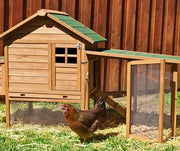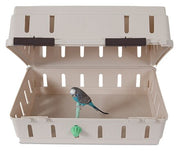Bird Toys with an Edge

The pet industry has certainly seen a lot of changes with pet toys in the last few years. Certainly, no one ever thought about guinea pig or rabbit or even hamster toys over a decade ago (except for the basics like the hamster wheel and exercise ball) and yet more and more toys are now being offered by manufacturers today. Of course, dog toys have been around for a very long time, and certainly rubber rings and balls along with the infamous ones like the vinyl pickle, rolled newspaper and porcupine that I played with in my father ’s store in the seventies are still being offered today. But some dog toys are now much more sophisticated with moving parts that make interesting sounds or will dispense a treat if moved in a certain way. Bird toys were actually the first to become more complicated because of birds, especially those in the parrot group, including parakeets and cockatiels, are extremely intelligent and need a lot of mental stimulation to keep them healthy and active.
FROM SIMPLE TO SOPHISTICATED
Bird toys in the seventies mostly consisted of wood with no color added, and I remember my yellow-nape Amazon parrot’s favorite toy in 1979 to be a piece of wood shaped like a hammer that he would hang next to and smack himself with (which I realize doesn’t sound very intelligent but he obviously got a kick out of it). Bird toys started to evolve by using many types of materials including rope, plastic, metal, and different types of wood but now the wood, like the plastic, was safely colored. This was a great step forward because birds can see full color, unlike canines, and therefore will prefer to play with toys that have lots of bright colors in them. But manufacturers didn’t stop there, especially not for toys made for larger parrots that have been shown to have the intelligence level of up to a three-year-old child. These birds needed toys that made them think and in some cases reward them with great things to chew on or eat.
GETTING A REWARD
Toys that an animal must work on to be rewarded in some way are called interactive intelligent toys or foraging when food is dispensed. The reward does not always have to be food related, although in many cases a treat will certainly keep many pets, especially dogs, more interested. Thus for birds, toys that have nuts or some other favored food placed inside in a way that the bird must move or chew away a certain part of the toy to get to the treat were some of the first interactive and foraging toys offered. But birds also can be rewarded with items they can chew on like rope, shredded paper or bits of wood, and thus a toy that has brightly colored, and sometimes flavored, wood or other chewable pieces inside can interest a parrot as much as a food item. But now bird toys go even a step further, understanding that parrots are smart enough to enjoy toys with no physical reward, but a more mental one.
Previous article

Next article

Related posts
View all-

How to Keep Your Pet Calm During Thanksgiving
Thanksgiving is a time for family, friends, and food, but for our pets, the holiday can be overwhelming. The sudden change in routine, unfamiliar faces and scents, and increased noise can trigger significant stress. Understanding why your pet might feel anxious is the first step toward creating a peaceful holiday experience for everyone, including your furry family members. This guide offers calming tips for pets and practical solutions to ensure your dog or cat feels safe and secure during the festivities.
Read Article -

Top Travel Essentials for Pets This Holiday Season
Holiday travel often means bringing the whole family along, and for many of us, that includes our furry companions. Preparing for holiday pet travel is about more than just packing a bag; it's about ensuring your pet's safety, comfort, and happiness from the moment you leave home until you return. A little planning helps reduce stress for both you and your pet, making the journey a positive experience for everyone involved.
Read Article -

Best Leashes and Collars for Daily Walks: A Pet Parent’s Guide
A daily walk with your dog isn't just a chore—it's a chance to bond, explore, and stay active together. The right leash and collar can make every walk safer and more enjoyable for both of you. With numerous styles and materials available, it's essential to find gear that suits your dog's needs and your lifestyle.
Read Article



